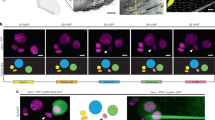Abstract
INSECT sense organs are produced by small groups of specialised epidermal cells1. The receptor neurones differentiate at the surface, so developing sensory axons grow inwards from the epidermis to the central nervous system (CNS). How do they find their way? During larval life the axons of newly differentiated sense cells combine with those of neighbouring receptors and thus are guided to the nearest branch of a peripheral nerve which carries them to the CNS2. At metamorphosis the axons of adult sensory neurones reach their central destination by growing along persistent larval nerves which are associated with the developing imaginal disks3–5. Thus with pathways to the ganglia already established, growth along existing nerves ensures the delivery of each generation of sensory axons to within a few hundred micrometres of their central targets. Just how the connection between the surface and the CNS is first established, whether by an outgrowth of nerves from the centre or by pioneering axons which grow inwards from the surface has never been shown, although some descriptions of embryonic development imply that the first axons to enter the developing appendages are growing outwards from the CNS6,7. Presumably these early centrifugal axons would provide a route for the later differentiating sensory fibres to follow in growth to the centre. Here, however, I report observations on the embryonic nervous system of Locusta migratoria which show that the first pathways between the epidermis and the central ganglia are formed by axons which grow inwards from peripheral neurones which differentiate early in embryonic life.
This is a preview of subscription content, access via your institution
Access options
Subscribe to this journal
Receive 51 print issues and online access
$199.00 per year
only $3.90 per issue
Buy this article
- Purchase on Springer Link
- Instant access to full article PDF
Prices may be subject to local taxes which are calculated during checkout
Similar content being viewed by others
References
Bate, C. M., in Handbook of Sensory Physiology, IX (edit. by Jacobson, M.) (Springer, Berlin, in the press).
Wigglesworth, V. B., Q. Jl microsc. Sci., 94, 93–112 (1953).
Meinertzhagen, I. A., in Development Neurobiology of Arthropods (edit. by Young, D.) (Cambridge University Press, London, 1973).
Melamed, J., and Trujillo Cenoz, O., J. ultrastruct. Res., 51, 79–93 (1975).
Sanes, J., and Hildebrand, J. G., Roux' Arch dev. Biol, 178, 71–78 (1975).
Baden, V., J. Morph., 60, 159–190 (1936).
Slifer, E. H., J. Morph., 58, 615–637 (1935).
Roonwal, M. L., Phil. Trans. R. Soc., B 227, 157–244 (1937).
Bate, C. M., J. Embryol. exp. Morph. (in the press).
Murphey, R. K., Mendenhall, B., Palka, J., and Edwards, J. S., J. comp. Neurol., 159, 407–418 (1975).
Lopresti, V., Macagno, E. R., and Levinthal, C., Proc. natn. Acad. Sci. U.S.A., 70, 433–437 (1973).
Author information
Authors and Affiliations
Rights and permissions
About this article
Cite this article
BATE, C. Pioneer neurones in an insect embryo. Nature 260, 54–56 (1976). https://doi.org/10.1038/260054a0
Received:
Accepted:
Issue Date:
DOI: https://doi.org/10.1038/260054a0
This article is cited by
-
Follicle-innervating Aδ-low threshold mechanoreceptive neurons form receptive fields through homotypic competition
Neural Development (2023)
-
Scanning laser optical tomography resolves developmental neurotoxic effects on pioneer neurons
Scientific Reports (2020)
-
A locust embryo as predictive developmental neurotoxicity testing system for pioneer axon pathway formation
Archives of Toxicology (2020)
-
Commissural axon guidance in the developing spinal cord: from Cajal to the present day
Neural Development (2019)
-
Dysregulation of axogenesis in the antennal nervous system of the embryonic grasshopper Schistocerca gregaria
Invertebrate Neuroscience (2019)
Comments
By submitting a comment you agree to abide by our Terms and Community Guidelines. If you find something abusive or that does not comply with our terms or guidelines please flag it as inappropriate.



